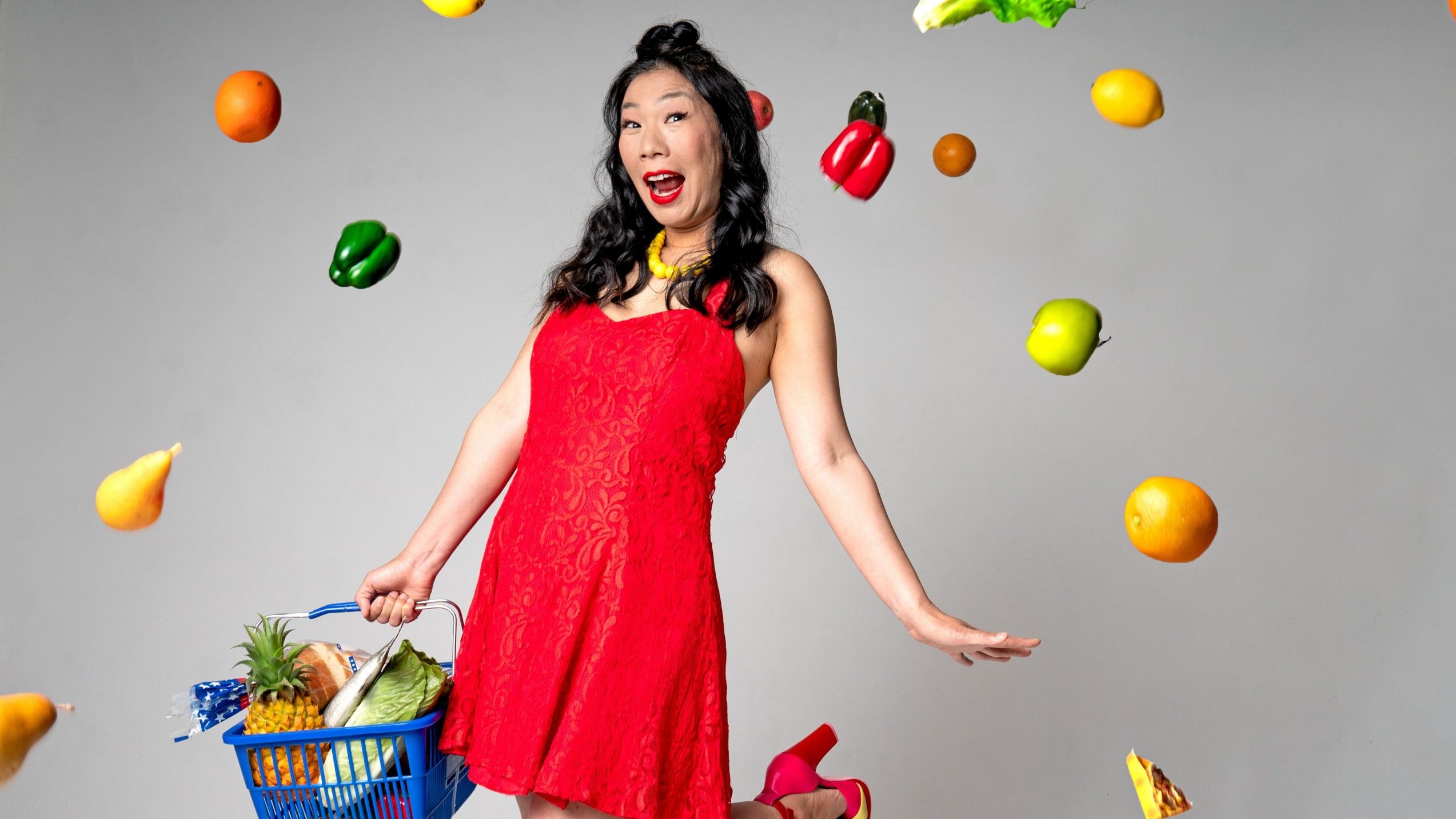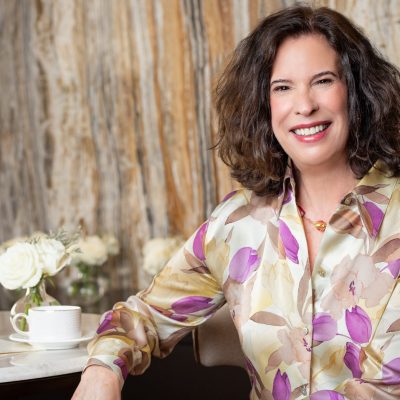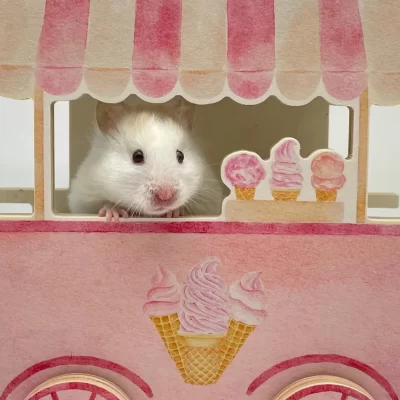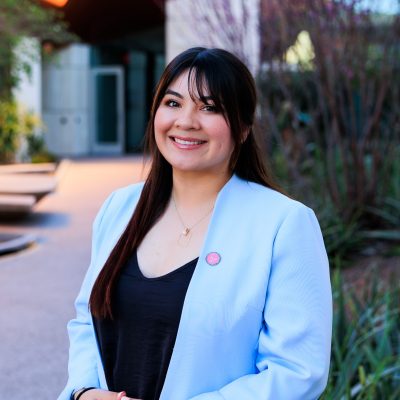10 Questions With… Kristina Wong

1. How does a performance artist, comedian and actor become an artist-in-residence at ASU?
Well, truth be told, ASU Gammage and I have been dating for a while. Back in 2010, I performed “Wong Flew Over the Cuckoo’s Nest” at the Beyond Series. A few years later, I performed “The Wong Street Journal.” So when I was invited to go steady for three years as ASU Gammage’s artist-in-residence in 2022, I knew our connection was real and worth the commitment.
2. You’re known as the “Food Bank Influencer.” How did that come about?
I stumbled upon World Harvest Food Bank in my neighborhood in Los Angeles in the fall of 2019. They use a nontraditional model that lets people “shop” their donations without having to show proof of income. It’s a model that gives people a sense of choice and, more importantly, dignity. I’d always thought food banks were for “other people who were in need.” But so much of now using a food bank to get my food and directing others to it as a resource has made me confront the moments of my life when I was actually food insecure. Choosing cheaper, unhealthier filler foods or choosing to skip meals — this is actually what food insecurity looks like. I also couldn’t stop talking about this place to people because it was so fun, and it was a fascinating way to understand our broken distribution systems that waste 40 percent of the food produced.
I found myself making videos for World Harvest the way beauty influencers do “haul videos” of fancy things they shop for. I figured I’d use my undeniable good looks at 45 years old to influence for the food bank!
During the pandemic, World Harvest became a vital part of the ecosystem of mutual aid that my group, the Auntie Sewing Squad, was doling out. We sent a lot of stuff from our food bank to both border communities for asylum seekers as well as to the Navajo Nation. Some of the Navajo organizers were so impressed by the food bank that they asked how they could set one up. Part of my wanting to research and create a show about food banks comes from trying to answer the question of how to help get more food banks like World Harvest started.
3. Where did your interest in food come from?
I never considered myself a big food aficionado until I was hit with an existential depression, which kicked off around the November 2016 election. I found myself unable to watch anything too intense. I was just getting through the days by watching YouTube haul videos or “unboxing videos.” That was as much plot as I could take, videos where people opened boxes and showed what was inside. Somehow, this led me down a rabbit hole of watching people challenging themselves to live on $10 a week in groceries. Then I found myself watching budget cooking videos and wowed by how far people could stretch if they really got creative, although some of the videos were sad in how unhealthy the meals were.
I wondered if it was possible for me to live on a small budget for groceries but also stay healthy and decided to see if I could live on $50 of groceries a month as a personal experiment. This was close to impossible, but when I found World Harvest, I found the only way I could pull it off and eat healthy. When the pandemic lockdown hit, grocery stores became my museums and art spaces. My only great stimulation in this time was food and how to cook it — but also thinking about how much emotion is tied to food and our ability to access it.
4. What’s the biggest misconception about food banks?
One is that they are in the charitable sector. They aren’t part of the government. Yes, there’s definitely government entities that will point people toward food banks and sometimes work in tandem with them to give away their food, but food banks are there to supplement what government programs like SNAP cannot. And SNAP doesn’t cover people as much as it should. Should SNAP benefits disappear, food banks have nowhere near the capacity to fill the need that SNAP fills in.
Also, I think we associate food banks with those canned food drives where people gather their dented, expired cans from the back of their pantries and give them away. I think that’s why there’s such a lack of dignity around going to a food bank, because we associate it with someone’s unwanted, rotting food. But most of the foods that food banks give away are much better than the worst of what we think people donate. There are also gaps in food manufacturing that push food out for sale too late and a grocery store won’t sell it because the food is close to the “best buy” date — which most of the time is just a suggestion. So some pretty good stuff can come through the food bank. And as the working poor grows in size, there is more of a reliance on food banks.
5. You weigh in on a lot of social issues with your work. Why is humor effective in dealing with big problems?
We need humor to survive and to give us some sense of control over the uncontrollable. And these are some pretty scary times.
6. You’re an elected representative of Koreatown, Los Angeles, and turned the experience into a rally campaign show. How do you stay motivated — and motivate others — in 2024?
I don’t know if it’s motivation as much as the house is on fire and you can either feel compelled to do something about the fire or just let yourself burn up with it.
7. Sewing is a signature of your work. How did you learn to sew?
My mother and home economics classes. With refreshers as an adult on YouTube and a few classes here and there.
8. You’ve been spending a lot of time in the Valley through your residency. What do you like to do here?
The coolest thing about being at ASU is getting to know this community the way you never could as a tourist. I was invited to be part of a cabaret that the ASU Gammage staff was performing for each other. The most hilarious act was the box office staff doing deadpan readings of complaints and comments they had received over the years. It was comedy gold. I’ve also been hanging out with the Pitchfork Pantry, the student-run pantry. Those student leaders are incredible.
9. Any favorite spots you recommend?
I don’t know if this is my favorite spot, but there’s a place in Tempe called Angie’s Lobster that does a $10 lobster roll with fries and soda! I know it sounds like an invite for food poisoning to eat lobster in a landlocked state, but I survived and don’t understand how they can be profitable.
10. What are you looking forward to next?
When I gave a graduate lecture last year called “Sex, Lies and Food Banks,” I was surprised when the CEO of St. Mary’s Food Bank came. Because they are the first food bank in the country, I had thought that they were too “big time” to ever take an interest in me, so I never thought to reach out. But they heard about the talk and have invited me to meet with them and see what they do. That’s exciting to me.
Kristina Wong will perform, teach and connect communities throughout the 2024-2025 academic year. She will bring a new show to ASU Gammage in April 2025. To learn more, go to asugammage.com.






